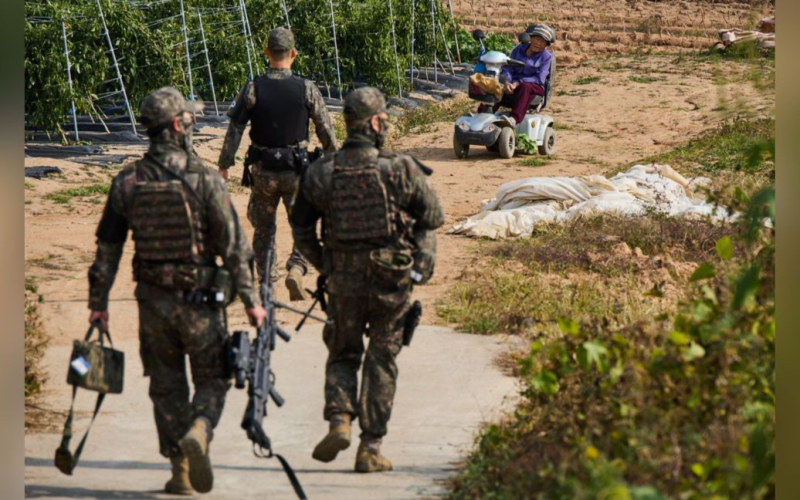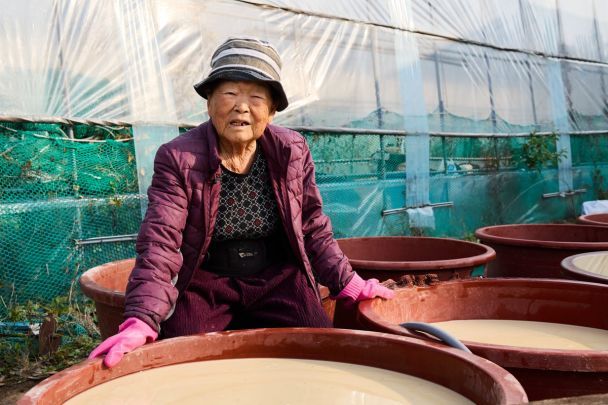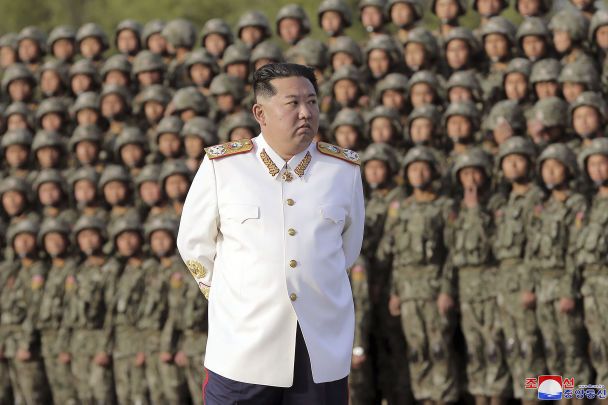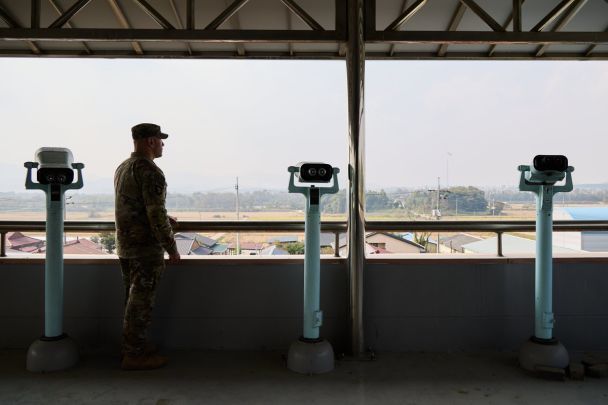
Journalists managed to visit a tiny village in the very heart of the demilitarized zone of Korea.
Gyung Ho and Mi Sun have a classic love story. They made eye contact at a party and immediately felt a spark. They quickly fell in love and Gen Ho asked Mi Sun to move in with him. But there was one “but” – Gen Ho lives in the only South Korean village in the demilitarized zone, just a few meters from North Korea.
Mi Sun's father was scared. He was so worried that he could not sleep after his first visit to them. “But actually, the hardest thing in our lives is that we can’t get fried chicken,” Mi Sun jokes. And also a strict night curfew.
TSN.ua offers you an adaptation of the BBC material about life in a hidden village a few meters from North Korea.
Life under close surveillance
Contrary to its name, the strip of no man's land separating North and South Korea is one of the most militarized places on earth. Fenced with barbed wire and carpeted with mines, hundreds of thousands of artillery shells are aimed in both directions. The territory was created in 1953 after the Korean War to separate the two armies. Hundreds of villages had to be cleared, forcing thousands of people to leave their homes.
But two villages were allowed to remain – the Village of Freedom, south of the ceasefire line, and the Village of Peace to the north.
These little beacons of hope were meant to signal that the DMZ was temporary and that Korea would one day be reunified. But 70 years later, the prospect of unification seems slim, and the village's population is dwindling as old people die and young people move away, making Gen Ho and Mi Soon with two young children unusual.
Living on the doorstep of one of the world's most hostile states comes with significant risks. Mi Sun remembers the eventful day last year when American soldier Travis King crossed the border from South Korea to North Korea while on an excursion in the demilitarized zone. Her children were immediately sent home from school and the residents were placed in isolation.
“Things like this happen every few years, and it reminds me that I live in such a village,” she says.
Tesung and its inhabitants
To reach Freedom Village, known as Daesung in Korean, journalists had to pass through several checkpoints. From there they drove north, past rows of armored tanks, until the land opened up, revealing dozens of golden rice fields and a small cluster of houses.
There are no restaurants, medical institutions, not a single store, and the villagers, many of whom are now 80-90 years old, live under the protection of more than 800 soldiers.
In a quiet courtyard stands a tiny elderly woman, hunched over from decades of farming, twirling a portion of homemade acorn jelly in her hands. A striped hat protects her weathered face and tousled hair.
Kim Dong Ryo was born on this land many years before the war decided her special fate. She remembers bullets flying past her window at night as the village came under crossfire.

“Don’t get me started on that terrible war,” she says, gesticulating vigorously. At 85, she outlived two of her six children, as well as a man who died young after being shot in the stomach by a North Korean soldier.
Raising children on her own, in a state of constant readiness, was stressful and lonely, she said, although life became easier over the years. At first there was only one bus a week that took them out of the DMZ, which meant that when she went out on the weekend to drink and dance, she was left on the streets until the following Friday.
But now the buses run three times a day, and now that her party days are behind her, she ventures out just once every two months to get her hair done.
“I wish I could do it more often, but it’s a hassle,” she shrugs.
One day, while collecting acorns to make jelly, Kim Dong Ryo noticed North Korean soldiers on the southern side of the front line. Frightened, she screamed and ran, and for good reason.
In 1997, her friend Hong was kidnapped by the North Koreans after she accidentally crossed the border while collecting acorns and was held captive for three days.
Mistress Kim is now accompanied by armed soldiers on most of her outings, which means she worries less. “We and the North Koreans live with our backs to each other,” she says.
Who rules the village
The village is run by the United Nations Command, a US-led army with soldiers from more than a dozen countries. The forces are responsible for maintaining the truce. There has never been a peace agreement between North and South Korea, and the people of Daesung are on the front lines of escalating tensions.
In November, both sides rearmed their troops in the demilitarized zone after the peace agreement fell apart. Then, earlier this year, North Korean leader Kim Jong Un called South Korea his number one enemy and said peaceful reunification of the two countries had become impossible.

“The village is not dangerous every day, but the risk is incredibly high,” said US Lt. Col. Chris Mercado, who leads the elite battalion of soldiers guarding the village. “Nowhere in the world is there anything like it.”
Lieutenant Colonel Mercado's soldiers patrol day and night. They even accompany residents when they are engaged in farming. They were preparing to take journalists to the fields near the border when they were warned of a potential threat.
A North Korean family has just fled the country and moved to South Korea by sea. Border guards in the North will be on high alert and likely to be watching the media's every move, and their presence could intimidate them. “So we have to stay where we are. This is a reminder of how unpredictable life can be in the demilitarized zone,” says the BBC material.

When the danger had passed, journalists entered the field along the line , separating North and South. While a local man plows the last of his rice harvest, two soldiers with machine guns stand guard, dressed head to toe in camouflage, their eyes scanning for anything moving to the north.
What locals are allowed to do
The village is not physically separated from North Korea by any fences or barriers. Only a rusty sign marks an invisible line, as well as a dense tangle of trees and bushes. As the sound of the plow subsides, the faint sound of soldiers singing on the north side can be heard.
“When I come here, my heart always breaks,” says Daesung Mayor Kim Dong-gu. “We are one people, but we cannot talk to each other, we can only watch from afar.”
During the day, the deceptive calm is disturbed only by the sounds of tractors or the barking of guard dogs. Mayor Kim is constantly concerned about the safety of her residents. “You may think it’s peaceful here,” he says, “but there’s an invisible creepiness here, an innate fear.”
As darkness falls, residents disappear into their homes. They need permission to leave the house after 19:00, and they are not allowed out after midnight. The soldiers begin the night roll call by knocking on the door, but this is a formality. The network of security cameras means they already know where everyone is.
Why do people stay here
To compensate for these rules and risks, the peasants are offered some significant benefits to convince them to stay. They pay no taxes or rent, and their extreme isolation combines with large amounts of agricultural land. Any crop they can't sell will be bought by the government.
That's a pretty good deal for Kim Kyung Ryo, who at age 16 took up arms to defend his village during the war. “I think it’s safe to say that this is heaven on earth,” he says, smiling.
87-year-old man boasts that he is not only one of the richest celebrities on the Korean Peninsula, but also has world-class security behind him.
But this did not stop us from installing our own surveillance cameras to track North Korean intruders.
Tesung's symbolism seems lost on Kim and the other founding inhabitants. They all say they stayed here out of habit and necessity – it was where they were born and farming was all they knew. But while the generation that fought for this land accepted the fact that they would die here, many of their children moved on.
All six of Kim's daughters left to continue their education and never returned. Each time he left, his heart broke even more.
During the visit of BBC journalists, his third daughter, Yun Kyun, visited him. She lovingly straightened his clothes and combed his hair. “When I was growing up, I felt like it was a dangerous place, but I wasn't afraid,” she said. “I simply had no reason to return.”
After university, she met her husband, got a job, and now the couple lives in Seoul with their children. For many years, men were allowed to bring their partners to live in the village, but women were not, forcing them to leave for love.
The rules were subsequently updated, but perhaps too late. Sleepy Tesung, with all his limitations, can no longer compete with the bright lights and limitless possibilities of modern South Korea. Over the past decade, its population has fallen from 213 to 138 people, and the proportion of elderly residents has doubled.
At the modern village elementary school attended by the children of Gen Ho and Mi Soon, there are only six students per class, and most of them come by bus from outside the demilitarized zone.
The couple's 10-year-old son seems unperturbed by his surroundings. He says he wants to live in Tesung forever, partly because it will free him from mandatory military service in South Korea, another of the village's privileges.
Probability of reunification of the South and North
But Mi Sun and Gen Ho have come to terms with the fact that their children will leave here one day. They want them to travel and experience the world behind the barbed wire. “Young people are asking too much to live here,” says Gen Ho, adding that in the future the village will probably not exist.
From the roof of the town hall there is a magnificent view of North Korea and the Peace Village in Gyeonggi with its majestic 165-meter flagpole. Lieutenant Colonel Mercado shows some buildings, explaining that they are only facades with painted over windows. It is believed that the North Koreans left Kijong long ago.
However, Lieutenant Colonel Mercado and his team at the United Nations Command are determined to keep Tesung and are looking for ways to convince people to stay.
One option is to reduce the number of nights that peasants must spend here to maintain their place of residence from the current eight months.
Lt. Col. Mercado fears that if they allow the village to disappear, it will send a signal that the South has given up on peace and reunification. “That would be a very strong signal that the terms of the truce are no longer being respected,” he says.
But every year a reunion looks less and less likely. Not only has the North officially abandoned the policy, but more South Koreans no longer believe it is necessary or even want it. As that dream fades, it becomes increasingly difficult to convince people to live on the front lines of an unresolved conflict.
Kim Dong Ryo says this will be the last year she makes acorn jelly. Last week she attended a friend's funeral. After that, another friend called her and begged her to hold on. “It’s just you and me left,” she said.
“I’m trying to hold on,” says Don Ryo. “But at our age it’s hard.” I will be gone, long before the village is gone.”
Read the leading news of the day:
Related topics:
More news

